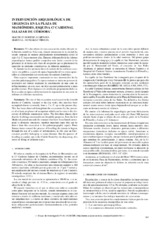Intervención arqueológica de urgencia en la Plaza de Maimonides, esquina C/ Cardenal Salazar (Córdoba)
Autor
González Vírseda, Marina L.
Moreno-Almenara, Maudilio
Editor
Junta de Andalucía, Consejería de CulturaFecha
2001Materia
Yacimientos arqueológicosPlaza de Maimonides (Córdoba, España)
Arqueología
METS:
Mostrar el registro METSPREMIS:
Mostrar el registro PREMISMetadatos
Mostrar el registro completo del ítemResumen
The site of this excavation was located in the Jewisth district of Cordoba. Located in the city walls, this area has been occuppied almont constantly from c. I a. C. up to the present day. This has been observed throughtout the excavations by the presence of at least six phases of occupation which can be seen in the discovery of different construction styles. The first three phases show that the fovildings excavated were for public purposes, from the low Medieval period anwards the remains that have been found correspond to domestic structures. Another important topic that can be drawn from this excavation is the paleotopographic aspect. From Roman times onward the process of levelling the terrain is begun, through the use of a series of substructures, in this case an hipocaustum possibly belonging to some thermas. But the process of levelling is carried out in the Califal Period by the depositing of a series of filling of different types. El solar objeto de esta excavación estaba ubicado en la Judería cordobesa. Esta zona, situada intramuros de la ciudad, ha estado ocupada de manera prácticamente ininterrumpida desde el siglo I d. C. hasta nuestros días. Durante el desarrollo de las labores arqueológicas hemos podido comprobar este hecho a través de la presencia de al menos seis fases de ocupación que se plasman en la aparición de entidades constructivas de diferente naturaleza. Si durante las tres primeras fases el carácter de los edificios excavados era público, a partir de época bajomedieval los restos aparecidos se corresponden con estructuras de carácter doméstico. Otro aspecto importante constatado en esta intervención fue la cuestión paleotopográfica. En época romana se inicia un proceso de nivelación del terreno mediante la construcción de una serie de infraestructuras, en este caso, un hipocaustum perteneciente a unas posibles termas. Pero el proceso de nivelación propiamente dicho se lleva a cabo en época califal mediante la deposición de una serie de rellenos de diferente naturaleza.

